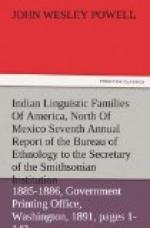The small amount of linguistic material accessible to the earlier writers accounts for the little done in the way of classifying the Pueblo languages. Latham possessed vocabularies of the Moqui, Zuni, A’coma or Laguna, Jemez, Tesuque, and Taos or Picuri. The affinity of the Tusayan (Moqui) tongue with the Comanche and other Shoshonean languages early attracted attention, and Latham pointed it out with some particularity. With the other Pueblo languages he does little, and attempts no classification into stocks.
GEOGRAPHIC DISTRIBUTION.
The Zuni occupy but a single permanent pueblo, on the Zuni River, western New Mexico. Recently, however, the summer villages of Taiakwin, Heshotatsina, and K’iapkwainakwin have been occupied by a few families during the entire year.
Population.—The present population is 1,613.
* * * * *
CONCLUDING REMARKS.
The task involved in the foregoing classification has been accomplished by intermittent labors extending through more than twenty years of time. Many thousand printed vocabularies, embracing numerous larger lexic and grammatic works, have been studied and compared. In addition to the printed material, a very large body of manuscript matter has been used, which is now in the archives of the Bureau of Ethnology, and which, it is hoped, will ultimately be published. The author does not desire that his work shall be considered final, but rather as initiatory and tentative. The task of studying many hundreds of languages and deriving therefrom ultimate conclusions as contributions to the science of philology is one of great magnitude, and in its accomplishment an army of scholars must be employed. The wealth of this promised harvest appeals strongly to the scholars of America for systematic and patient labor. The languages are many and greatly diverse in their characteristics, in grammatic as well as in lexic elements. The author believes it is safe to affirm that the philosophy of language is some time to be greatly enriched from this source. From the materials which have been and may be gathered in this field the evolution of language can be studied from an early form, wherein words are usually not parts of speech, to a form where the parts of speech are somewhat differentiated; and where the growth of gender, number, and case systems, together with the development of tense and mode systems can be observed. The evolution of mind in the endeavor to express thought, by coining, combining, and contracting words and by organizing logical sentences through the development of parts of speech and their syntactic arrangement, is abundantly illustrated. The languages are very unequally developed in their several parts. Low gender systems appear with high tense systems, highly evolved case systems with slightly developed mode systems; and there is scarcely any one of these languages, so far as they have been studied, which does not exhibit archaic devices in its grammar.




